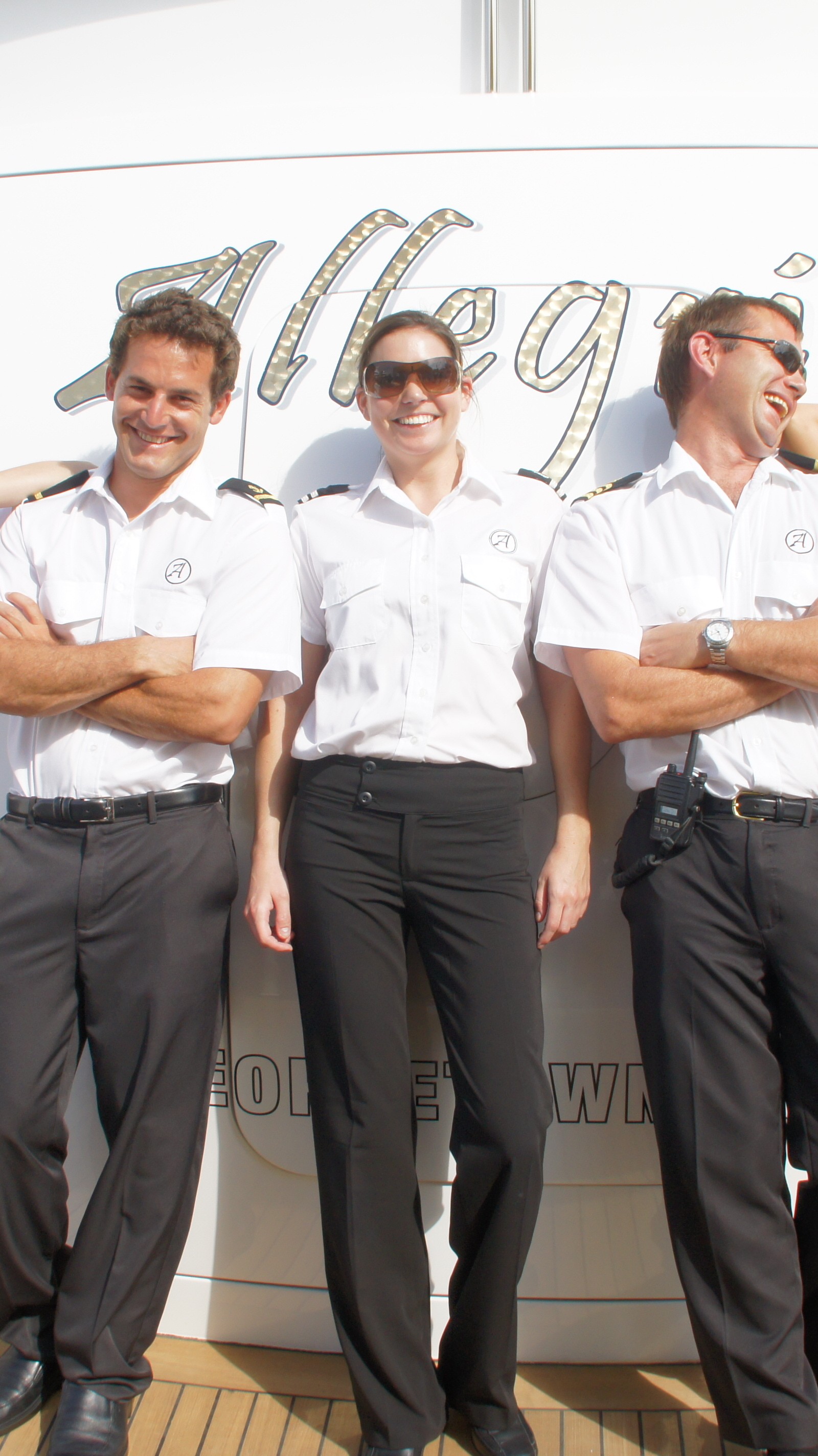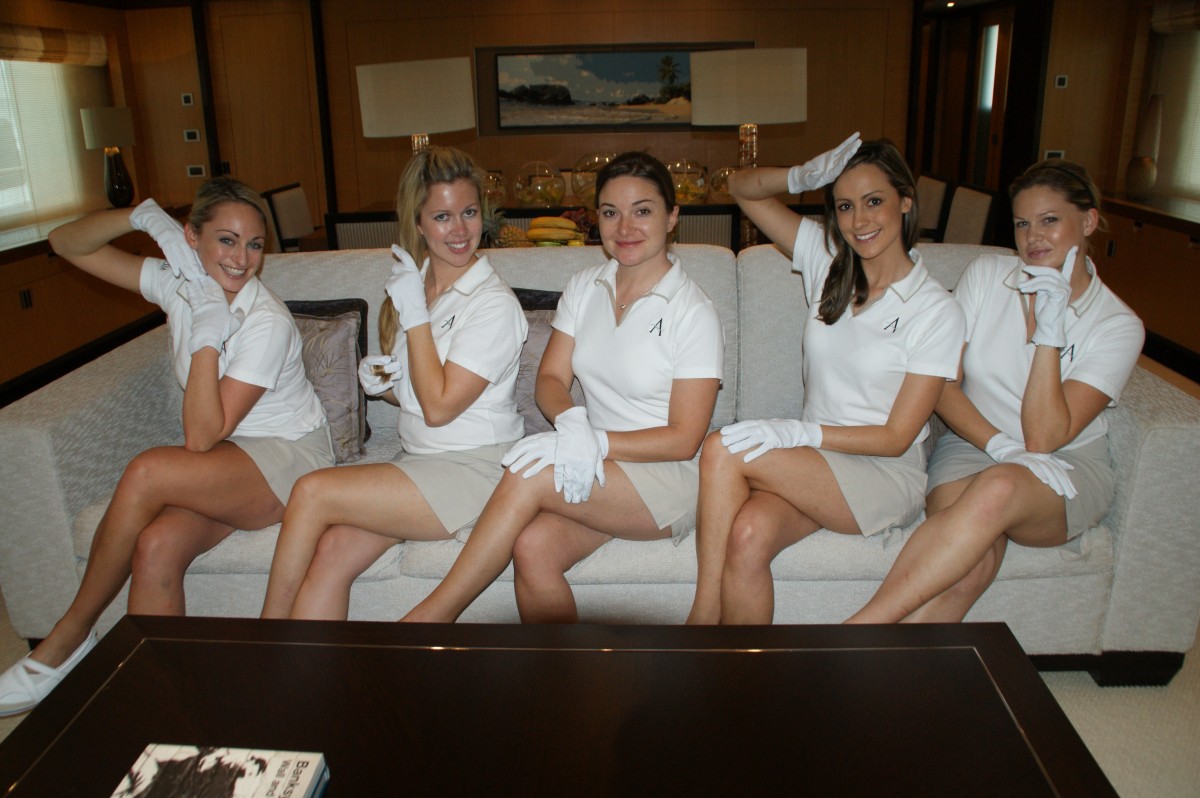For some even more straight-from-the-book fun, I present to you below the official job descriptions for the various yacht steward/ess roles. These are pulled directly from The Insiders’ Guide to Becoming a Yacht Stewardess Chapter 3—a chapter that actually contains descriptions for each of the positions onboard, from Captain to Engineer, and from Executive Chef to Deckhand. And they are all presented with accompanying salary ranges.
So if you’re interested in a yachting career in another department outside of a superyacht’s interior, consider picking up a copy of my book to learn more. (The “how to get started” information in Part II of the book really does pertain to most any entry-level position.)
Official Yacht Steward/ess Job Descriptions
Meanwhile, here are your yacht stewardess job descriptions, with a detailed salary chart found at the end of this post:
CHIEF STEWAR/DESS (Annual Salary Range: $39,000–$96,000+)
Job Function—The chief stewardess will carry out his or her duties and responsibilities under the direction and authority of the captain. As the person ultimately responsible for the interior of the vessel and for providing superior hospitality service to meet the owner’s and guests’ expectations, the chief stew will also train and manage any lower-ranking stews under his or her supervision. Excellent service, host/ess, and managerial skills are a necessity, as is having a good degree of creative flair.
Responsibilities
- Responsible for the everyday smooth operation of the boat’s interior department, which means being adept in the arts of housekeeping services, laundry procedures and wardrobe management, food and beverage service and cleanup, and entertaining (while maintaining proper etiquette and a high-energy, can-do attitude at all times)
- Responsible for directing, motivating, and training the lower-ranked stews (2nd, 3rd, and so on)—if any are onboard—which includes the assignment and scheduling of rotational duties and implementing Human Resources (HR) procedures and guidelines
- Providing valet services and overall guest care. Note: In the hospitality industry, “valet” refers to any employee who performs personal services for guests (and refers to more than just parking cars, which is what we normally associate it with). With regard to yacht stews, valet services include tasks such as packing and unpacking guests’ luggage, caring for their personal items and specialty garments, and even making daily activity arrangements for them.
- Protecting, maintaining, and caring for valuable interior items and surfaces, such as artwork, silks, china, crystal, linens, fine woodwork, and marbles
- Creating, implementing, and monitoring a financial planning system that includes accounting and budgeting for interior department needs
- Creating, implementing, and maintaining an informational management system of interior inventories and maintenance procedures
- Provisioning to maintain inventory supplies and cover guest usage
- Collaborating with the executive chef regarding meal service for the guests
- Creative planning and quality service of theme dinners and occasional guest parties
- Keeping all interior storage areas organized, orderly, and maintained
- Crew uniform purchasing
- Writing and updating all interior manuals and guest-information documents
- Maintaining and displaying knowledge of international etiquette and protocol
- Watchkeeping in accordance with the list of responsibilities in the crew mess
- Exterior-crew support as needed (requiring proficiency with exterior lines and fenders)
- Selecting, purchasing, and serving fine wines, specialty teas, and cigars, which may require advanced training
- Planning and managing destination experiences proficiently
- Assuming full responsibility for certain onboard safety tasks (as assigned by the first mate) in an emergency
Qualifications—A chief stewardess should possess some type of training and experience in the areas of bartending, silver service, cigar service, and wine presentation and service. (The more extensive a stew’s wine knowledge, the better.) STCW BST certification is now mandatory for a chief-stew position, and previous yachting experience on either charter or private vessels is most always required. It is also recommended that you obtain an ENG1 Seafarer Medical Certificate, or its equivalent. Floral arranging and table decorating skills prove to be an advantage, while an Advanced/Medical First Aid Certificate or a higher degree of medical training is also a major bonus. In fact, many chief stews are now taking courses to become certified as a yacht’s Medical Person-in-Charge. This requires a seven-day course that will satisfy the standards set forth by the STCW Code A-VI/4, 4.4-4.6, offered at many of the marine training schools. While the new PYA Interior-Crew G.U.E.S.T certification is not mandatory (as of July 2013), it is wise to follow the courses outlined and seek out equivalent intermediate and/or advanced interior-crew training classes, if not sign up for the full PYA G.U.E.S.T course modules.

A Chief Superyacht Stewardess handles the ordering of provisions and other guest amenities for the yacht, which might include things like floral displays that the interior crew is too overwhelmed to handle on its own. While that may sound like an easy task, consider that no matter how many years a yacht stew has been doing this job, he or she will always end up in a new port (sometimes half-way around the world). First, he or she must find a reputable vendor. And not only do fresh flower arrangements need to be ordered, but they must be paid for as well. A chief stew must keep thorough accounting throughout a trip and make sure all vendors and provisioners are paid from the right accounts.
Photo Credit: Suki Finnerty of YachtingToday.TV.
STEWARDESS—2nd and 3rd Stews; sometimes referred to as Senior and Junior Stews (Annual Salary Range: $30,000–$54,000+)
Job Function—A 2nd or 3rd stew will carry out his or her duties and responsibilities under the direction and authority of the chief stew and the captain. Individuals holding these positions are responsible for assisting with the maintenance of the interior of the vessel and providing superior hospitable service, in line with the owner’s and guest’s expectations. Hostess skills should be well developed to fully accommodate the owners and their guests while onboard.
Responsibilities
- Maintaining interior housekeeping during a trip (detail cleaning) while also being held largely responsible for guest-cabin care
- Laundry, ironing, and other wardrobe maintenance tasks for guests and sometimes crew (when guests are onboard)
- Applying excellent guest service (including silver service) and expert bartending skills when called upon
- Guest care and valet services
- Assisting in the creative planning and quality service of theme dinners
- Assisting with physical product inventories, provisioning, writing and updating checklists, and all other applicable tasks within interior
- Maintaining and displaying knowledge of international etiquette and protocol
- Watchkeeping in accordance with the list of responsibilities in the crew mess
- Exterior-crew support as needed
- Assuming full responsibility for certain onboard safety tasks (as assigned by the first mate) in an emergency
Qualifications—This is an entry-level position; while previous yachting experience is not required, it does bring added salary benefits. STCW BST certification is now mandatory for obtaining even entry-level work on a megayacht. It is also recommended that you obtain an ENG1 Seafarer Medical Certificate, or its equivalent. Table service, bartending, and cocktail-service experience or equivalent qualification are crucial to landing a job—training and certification recommendations for these can be found in Chapter 7 of The Insiders’ Guide to Becoming a Yacht Stewardess. While the new PYA Interior-Crew G.U.E.S.T certification is not mandatory (as of July 2013), it is wise to follow the courses outlined and seek out equivalent introductory interior-crew training classes, if not sign up for the full PYA G.U.E.S.T introduction modules.
Dual Positions
On smaller and midsize vessels, where not as many crewmembers are needed (nor is there room for them), the core crew positions listed in the last section are often fused into what I call “dual positions.” An individual hired into such a position will assume a dual role and be expected to wear more than one “hat” during the course of a day.
Here are some examples:
- Deckhand-Stew
- 2nd Engineer-Deckhand
- Captain-Engineer
- Stew-Chef
- Stew-Purser
Steward/ess Salaries
According to Dockwalk’s annual Crew Salary Survey in September 2013, steward/esses are making a wide variety of salaries these days, and the amount of experience and training they have makes a difference. Of course, the size of the yachts will also be a factor. Compensation for chief stews runs anywhere from $3,450 to $5,650 a month on smaller yachts (80 to 140 feet) to $5,200 to $8,000 a month on yachts over 140 feet. It is very common now to see $65K and $70K salaries, or even $90K+ on the much larger vessels. Salaries for entry-level yacht stewardesses start out between $30K–$43K a year, or $2,500–$3,600 a month.
Base salaries for stewardesses, when compared with those of food and beverage servers, cabin stews, and laundry staff on cruise ships, are slightly higher. But where the potential income differences become dramatic is when you consider the tips one can earn working on luxury charter yachts, or the bonuses and perks afforded the crew on solely private yachts.
Here is a table that sums up salary ranges for the various stew roles within the interior department on a megayacht / superyacht:
Steward/ess Salary Ranges
| STEWARD/ESS RANK | UNDER 100 FT. (30M) | 100–140 FT. (30–40M) | 140–180 FT. (40–55M) | OVER 180 FT. (55+M) |
|---|---|---|---|---|
| TOTAL # OF CREW | 1–4 | 4–8 | 6–12 | 12+ |
| Chief Steward/ess (sometimes called a Head Steward/ess) | $3,300–$4,000 pm or $39K–$48K pa | $4,000–$5,500 pm or $48K–$66K pa | $5,200–$7,000 pm or $62K–$84K pa | $7,000–$8,000+ pm or $84K–$96K+ pa |
| 2nd Steward/ess (sometimes called a 1st or Senior Steward/ess) | N/A | $3,000–$3,800 pm or $36K–$45K pa | $3,300–$4,500 pm or $39K–$54K pa | $4,000–$4,500+ pm or $48K–$54K+ pa |
| 3rd Steward/ess (sometimes called a Junior Steward/ess) | N/A | $2,500–$3,200 pm or $30K–$38K pa | $2,800–$3,400 pm or $33K–$40K pa | $3,000–$3,600 pm or $36K–$43K pa |
| pm = per month • pa = per annual Crew salary information taken from various online and agency sources and cross-checked against Dockwalk’s annual Crew Salary Survey, September 2012. |
||||
While annual salary guidelines are given above, again, keep in mind that the ranges are wide because salaries will depend on a variety of factors, including the size of the yacht, the use of the yacht (private or charter), the style of boat (power or sail), and what other benefits are available to the crew, such as insurance packages or education reimbursement. Salaries may also vary depending on the specific qualifications of a crewmember, the amount of time the owner and guests use the vessel, and what itinerary will be traveled. Furthermore (and I cannot emphasize this enough), the compensation ranges listed are base salaries and do not reflect tips, if those are applicable.
Yacht Crew Have Got 99 Problems, But Living Expenses Ain’t One of Them
The first thing people always say after I give them the above salary figures: “Gee, is that all? I thought you said it paid well?” And someone will always add, “Oh, well I can get paid that same amount to take an entry-level office job.”
But here’s the kicker: no expenses.
Most all positions on luxury yachts require you to live aboard and travel with the vessel, and therefore, your room and board are completely covered. It is customary and expected that everything you need on a daily basis is provided by the yacht owner—your meals, your uniforms, laundry detergent, linens, and on most boats, even your personal hygiene products, such as soap and toothpaste. Meanwhile, your earnings automatically go into your bank account.
What other job can you take where, at the end of the year, you have nearly your entire salary sitting in your bank account, relatively untouched? Most people in other industries are lucky if they save 1/10 of the amount they earn in a year. Why? Because they are paying rent and utilities, buying and maintaining cars, and purchasing all the clothes they wear to work each day. And let’s not forget groceries.
Ready to find out how to get started one your way to working on a yacht? All the advice you need to land that first yacht job can be found in this guide. Good luck!








This is something I really would like to do !! I’m going to check into getting the training !!